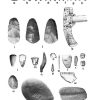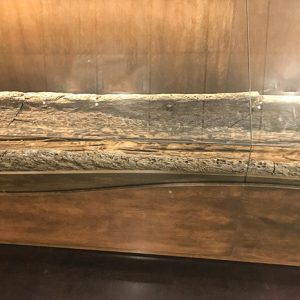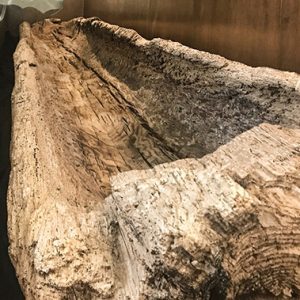calsfoundation@cals.org
Peeler Bend Canoe
The Peeler Bend Canoe is an extremely rare and well-preserved relic of Arkansas’s Native American heritage. Found by chance in 1999, the canoe is believed to have been made by members of the Caddo tribe. Radiocarbon dating places the canoe’s creation sometime between AD 1160 and 1300. After spending several years at the Historic Arkansas Museum (HAM) in Little Rock (Pulaski County), the Peeler Bend Canoe was placed on display in Riverside Park in Benton (Saline County). The canoe has been loaned to the City of Benton by the Department of Arkansas Heritage for exhibition until March 15, 2020.
In August 1999, Benton resident Charles Greene was fishing in the Saline River near the Peeler Bend access located just outside of Benton. Greene parked his boat on a sandbar to have lunch when he spotted what he thought was a petrified log nearby. Upon closer inspection, the “log” turned out to be a twenty-four-foot-long dugout canoe. The canoe was visible to him because the water level was lower than usual due to a lack of summer rainfall.
After Greene contacted the Gann Museum in Benton for help, the museum sent amateur archaeologists Guy Moore and Ruben Rankin to examine the canoe. After their inspection, a group of volunteers—including former mayor of Benton, Rick Holland—went to dig out the canoe and walk it downriver to the Lyle Park access. It was then loaded onto a trailer bound for Moore’s home in Benton. The canoe was preserved in a small pond at the recommendation of Dr. Ann Early of the Arkansas Archeological Survey (AAS). Early contacted the commissioner of state lands, who determined that the canoe was state property. Early arranged for the canoe to be placed in the pond of AAS member Dr. Quinn Baber, as keeping it in water prevented it from drying out and falling apart in the hot sun.
In December 2001, the canoe was moved from the pond in Benton to HAM in Little Rock for conservation and preservation, and to be displayed in an upcoming exhibit on the anniversary of the Louisiana Purchase. On April 23, 2003, the canoe was added to HAM’s permanent collection. Andrew Zawacki, an expert in wood conservation at HAM, stabilized the canoe by having it submerged in a large holding tank containing water and polyethylene glycol, or PEG. The solution conserved the canoe by migrating into its cellular structure to replace any water within it, strengthening the canoe’s physical structure to stop it from collapsing.
The canoe was determined to be a prehistoric dugout because charring was found in the canoe’s interior cavity, providing evidence of burning and scraping rather than the use of metal tools. Furthermore, a small sample taken by AAS archaeologists and sent to Beta Analytic for radiocarbon dating revealed that it was around 800 years old. Because of where it was found and its age, it is certain that the canoe was used by Native Americans, possibly members of the Caddo tribe. One other dugout canoe has been found in Arkansas. The Griggs Canoe, also found in the Saline River, is on display at Plum Bayou Mounds Archeological State Park in Scott (Lonoke and Pulaski counties). According to the Griggs family, the canoe been deposited in their backyard after a flood.
After years of discussion between HAM and the City of Benton, the Peeler Bend Canoe was moved again. On April 9, 2017, the Tri-Lakes Edition of the Arkansas Democrat-Gazette reported that the canoe was being loaned to the City of Benton for display at its new Riverside Park, located along Interstate 30 near the Saline County Fairgrounds. The City of Benton’s economic director, Brad Jordan, and Mayor David Mattingly, with the support of local citizens, convinced the Department of Arkansas Heritage to return the Peeler Bend Canoe to Saline County. Originally, it was to be displayed at the Benton Event Center, but that location could not accommodate the large artifact, so it was placed under glass at the much larger River Center at Benton’s Riverside Park.
The canoe, carved from a yellow pine log, measures twenty-four feet long and twenty-six inches wide. The canoe’s interior cavity slopes from bow to stern (front to back), with gunwales (walls) averaging ten centimeters in thickness, and the stern has two grooves on top, paralleling the length of the canoe. A large stone was found with the canoe, thought to have been used as an anchor.
For additional information:
Dailey, Don. “Dugout Dug out of Saline Riverbed.” Benton Courier, August 31, 1999, pp. 1, 3.
Pierce, Sam. “Ancient Canoe Now on Display at New River Center in Benton.” Arkansas Democrat-Gazette, Tri-Lakes Edition. April 9, 2017. Online at http://www.arkansasonline.com/news/2017/apr/09/ancient-canoe-now-display-new-river-center-benton/?f=trilakes (accessed September 7, 2017).
Trubitt, Mary Beth. “Update on the Peeler Bend Canoe: An Ancient Dugout Canoe from Saline County.” Field Notes (Arkansas Archaeological Survey) 307 (July/August 2002): 3–4.
Cody Lynn Berry
University of Arkansas at Little Rock
 Historic Preservation
Historic Preservation Pre-European Exploration, Prehistory through 1540
Pre-European Exploration, Prehistory through 1540 Peeler Bend Canoe
Peeler Bend Canoe  Peeler Bend Canoe
Peeler Bend Canoe  Peeler Bend Canoe
Peeler Bend Canoe 




Comments
No comments on this entry yet.